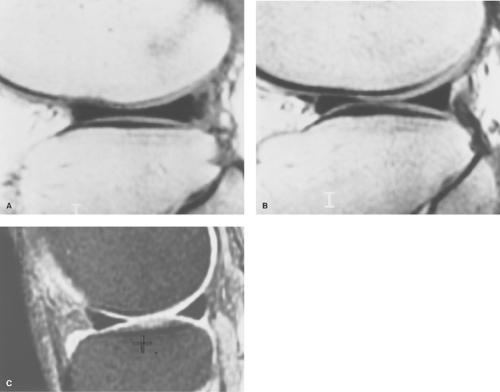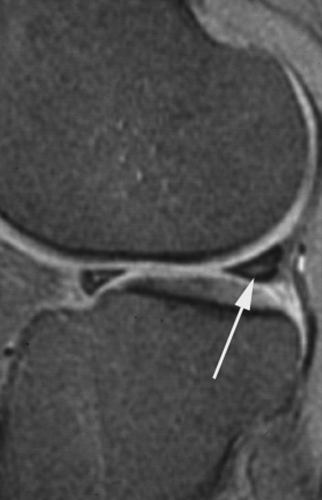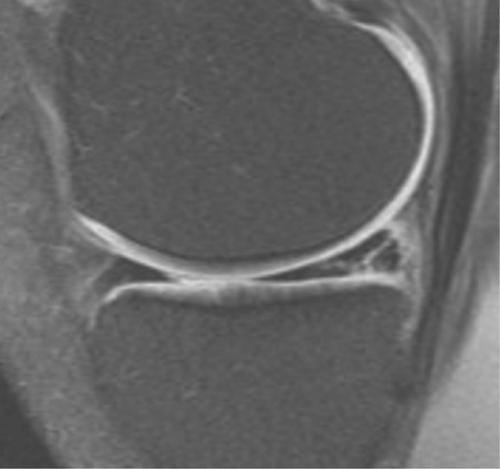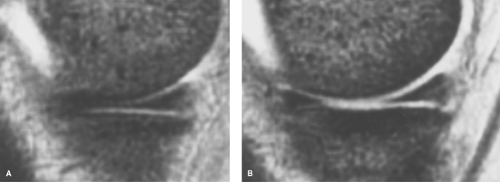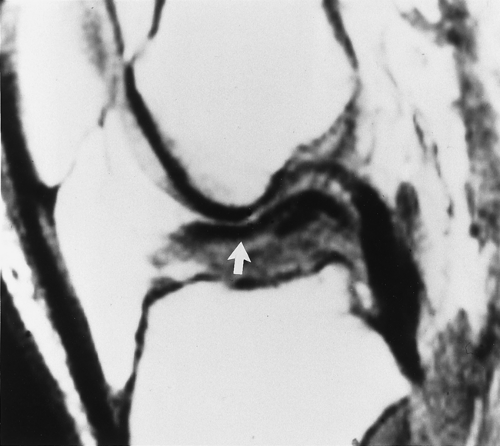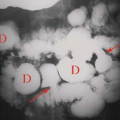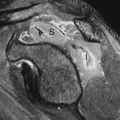Magnetic Resonance Imaging of the Knee
Clyde A. Helms
MR of the knee has developed into one of the most frequently requested examinations in radiology. This is because of its inherent accuracy in depicting internal derangements and its ability to allow orthopedic surgeons to use it as a road map for subsequent therapeutic arthroscopic procedures. Also, MR has a very high negative predictive value; therefore, a normal MR knee examination is highly accurate in excluding an internal derangement (1,2).
Technique
The proper imaging protocol is essential for a high diagnostic accuracy rate. If the appropriate sequences are obtained, an accuracy of 90% to 95% can be expected. A sagittal T1W (or proton-density) sequence is essential for examining the menisci, and 4- or 5-mm-thick slices with a relatively small field of view and at least a 256 × 192 matrix are recommended. The knee should be imaged using a dedicated knee coil and externally rotated about 5° to 10° (should not exceed 10°) to put the anterior cruciate ligament (ACL) in the plane of imaging. T2 fast spin-echo (FSE, also called turbo spin-echo) or T2* GRASS (gradient-recalled acquisition in the steady state) sagittal images are obtained primarily to examine the cruciate ligaments and cartilage.
FSE sequences are particularly poor for examining the menisci. Even when performed as fast proton-density images with a short echo train length, they have too much blurring to provide an accurate demonstration of meniscal tears. Conventional spin-echo images have consistently given a sensitivity for meniscal tears in the 90% to 95% range, whereas FSE proton-density sequences have been reported in multiple papers to be only around 80% sensitive for meniscal tears.
Coronal images are obtained to examine the collateral ligaments and cartilage and to look for meniscocapsular separations. These abnormalities can generally only be seen with T2WIs. Coronal T1WIs are therefore a waste of time, because nothing can be seen on these images that cannot be seen equally as well on the sagittal images or the T2 or T2* coronal images. The coronal images are useful for confirming a meniscal tear that is seen on the sagittal images, especially radial tears. It is rare to see a linear tear solely on the coronal images; therefore, coronal meniscus-sensitive sequences are typically not necessary.
Axial images are used for viewing the patellofemoral cartilage, identifying bursal fluid collections, and examining a medial patellar plica. As for the coronal images, to afford an opportunity to see any pathology, T2WIs must be obtained.
Menisci
The normal meniscus is a fibrocartilaginous, C-shaped structure that is uniformly low in signal on both T1WIs and T2WIs. Many centers have found that the menisci are more easily examined if they fat-suppress the T1 or proton-density sequences (Fig. 47.1). With T2* sequences, the menisci will usually demonstrate some internal signal. With T1WIs, any signal within the meniscus is abnormal, except in children, in whom some signal is normal and represents normal vascularity.
Meniscal Degeneration. Meniscal signal that does not disrupt an articular surface is representative of intrasubstance degeneration (Fig. 47.2), which is myxoid degeneration of the fibrocartilage. It most likely represents aging and normal wear and tear. It is not thought to be symptomatic and cannot be diagnosed clinically or with arthroscopy. Some choose, therefore, not to mention intrasubstance degeneration in the radiology interpretation. A grading scale for meniscal signal that is widely used is the following (Fig. 47.3): grade 1, rounded or amorphous signal that does not disrupt an articular surface; grade 2, linear signal that does not disrupt an articular surface; and grade 3, rounded or linear signal that disrupts an articular surface. Grades 1 and 2 are intrasubstance degeneration and should not be reported as “grade 1 or 2 tears,” since the term “tear” can lead to unnecessary arthroscopy (arthroscopy is not indicated for intrasubstance degeneration). Grade 3 is a meniscal tear.
Meniscal Tear. When high signal in a meniscus disrupts the superior or inferior articular surface, a meniscal tear is diagnosed (Fig. 47.4). Meniscal tears have many different configurations and locations; an oblique tear extending to the inferior surface of the posterior horn of the medial meniscus is the most common type. In a small but significant percentage of cases, it can be virtually impossible to be certain whether meniscal high signal disrupts an articular surface. In these cases, it is recommended that the surgeon be advised that it is too close to call. The surgeon can then rely on his or her clinical expertise to decide if arthroscopy is warranted, and if it is, the MR will guide the surgeon to the location of the questionable tear. If these equivocal cases are excluded, the remaining cases will have an extremely high accuracy rate.
It has been shown that MR imaging sensitivity for meniscal tears decreases significantly when the ACL is torn (3). These frequently overlooked tears occur in the periphery of the meniscus and in the posterior horn of the lateral meniscus. Hence, great care must be used in examining these areas of the menisci in patients with ACL tears.
Bucket–Handle Tear. A common meniscal tear is a bucket–handle tear, reported in up to 10% of some series. This is a vertical longitudinal tear that can result in the inner free edge of the meniscus becoming displaced into the intercondylar notch (Fig. 47.5). It is most easily recognized by observing on the sagittal images that only one image is present that has the bow-tie appearance of the body segment of the meniscus (4) (Fig. 47.6). Normally, two contiguous sagittal images with a bow-tie shape are seen, because the normal meniscus is 9 to 12 mm wide and the sagittal images are 4 to 5 mm in thickness. On the coronal images, a bucket–handle tear may reveal the meniscus to be shortened and truncated; however, the torn meniscus often remodels and truncation cannot be appreciated. The displaced inner edge of the meniscus (the “handle” of the bucket) should be seen in the intercondylar notch on sagittal or coronal views (Fig. 47.7).
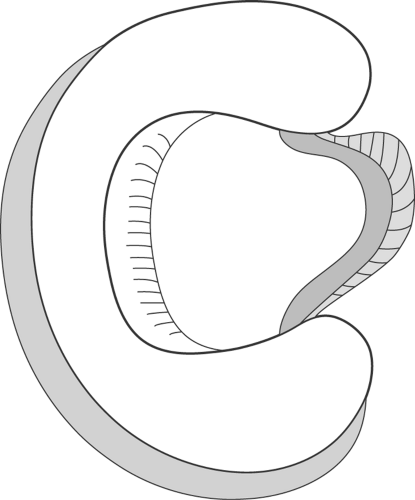 Figure 47.5. Bucket–Handle Tear. This drawing illustrates a bucket–handle tear, with the torn free edge of the meniscus displaced as the handle of the bucket. |
Discoid Meniscus. A discoid meniscus is a large meniscus that can have many different shapes: lens-shaped, wedged, flat, and others. Whether it is congenital or acquired is not known. It is seen laterally in up to 3% of the population, with a discoid medial meniscus being much less common. A discoid meniscus is thought to be more prone to tear than a normal meniscus, and it can be symptomatic even without being torn. Although they are easily identified on coronal images by noting extension of meniscal tissue into the tibial
spines at the intercondylar notch (Fig. 47.8), they are most reliably diagnosed by noting more than two consecutive sagittal images that show the meniscus with a bow-tie appearance (Fig. 47.9) (5).
spines at the intercondylar notch (Fig. 47.8), they are most reliably diagnosed by noting more than two consecutive sagittal images that show the meniscus with a bow-tie appearance (Fig. 47.9) (5).
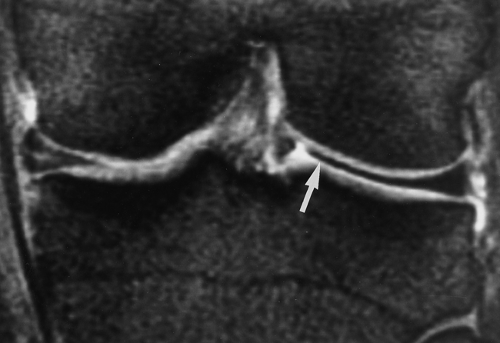 Figure 47.8. Discoid Lateral Meniscus. A coronal gradient-echo image through the intercondylar notch shows a large lateral meniscus, with meniscal tissue extending into the notch medially (arrow). |
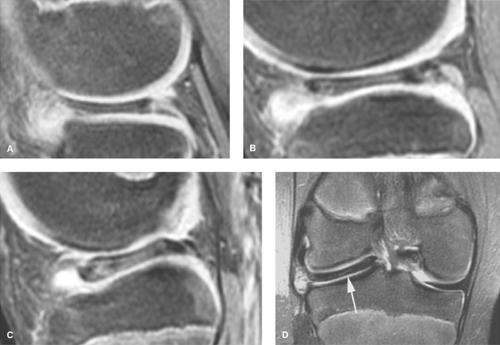 Figure 47.9. Discoid Lateral Meniscus. Three consecutive 4-mm-thick proton-density images through the lateral meniscus, beginning with the most lateral (A) and extending medially (B, C), each showing the meniscus to have a bow-tie configuration. Because only two images should have a bow-tie shape, indicative of the body of the meniscus, this is diagnostic of a discoid lateral meniscus. D. A coronal T2WI shows the discoid lateral meniscus (arrow) to be much larger than the medial meniscus and extending into the intercondylar notch.
Stay updated, free articles. Join our Telegram channel
Full access? Get Clinical Tree
 Get Clinical Tree app for offline access
Get Clinical Tree app for offline access

|
